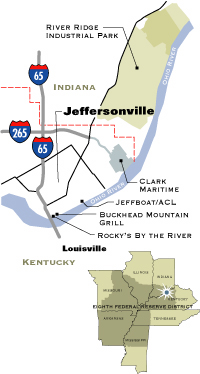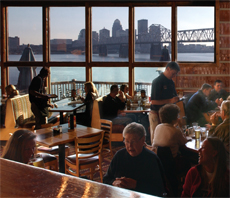Community Profile: River Keeps Jeffersonville, Ind., Economy Rolling
|
|||||||||||||||||||||||||||||||||||||||
For a mile and a quarter on the northern bank of the Ohio River, in Jeffersonville, Ind., barge building gets top priority.
Machinists, carpenters, pipe fitters and other trades people will complete about 350 barges this year for Jeffboat, a subsidiary of Jeffersonville-based American Commercial Lines. Jeffboat, just across the river from Louisville, Ky., also builds towboats and manages a dockside repair facility. The company calls itself the largest inland boat-building company in the United States.
ACL operates 3,200 barges and 124 towboats that transport more than 45 million tons of freight annually, mostly on the inland waterways of North America. ACL International transports bauxite (an ore used to make aluminum) along 355 miles of the Orinoco River in Venezuela.
Chris Black, ACL's chief financial officer, says, "Our business and our industry are probably better positioned today than they have ever been. And our balance sheet is certainly the strongest it has ever been."
Like many industries, barge building is cyclical. Right now, the cycle is up. In November 2005, Jeffboat added 100 hourly jobs, most of which pay between $18-20 an hour.
Jerry Linzey, senior vice president for manufacturing at ACL, says revenue at Jeffboat should reach $220 million this year and zoom up to about $300 million next year. Total revenue at ACL last year was $600 million.
Barge building is booming for several reasons. For one, it's relatively cheap to ship products by barge—an important consideration in this age of rising energy prices. One gallon of fuel will transport one ton of barge cargo for 500 miles. That compares with 200 miles by rail and 60 miles by truck.
"Hauling by barge is the most fuel-efficient, safest mode of transportation," says Norb Whitlock, senior vice president and chief operating officer of ACL.
Builders also are benefiting because many barges built during a boom 25 years ago now need replacing. Spot shortages are popping up, says Black.
Whitlock says, "We're going to see strong demand in the barge industry for at least the next three to five years."
The decision to go public also has helped ACL. The company filed for an initial public offering (IPO) in July 2005, at a price of $21 a share. In October, ACL announced that it had sold almost 9.5 million shares of common stock.
"Bottom line, we've been able to go from about $400 million in debt to about $200 million in debt, and $150 million of that was from the IPO," Black says. "The company has emerged much stronger than before."
|
Beyond Barges
Growth at ACL should at least partly offset the closing of the Colgate-Palmolive plant in neighboring Clarksville. Colgate-Palmolive executives announced in October that the toothpaste-making plant will stop production by January 2008. About 500 employees will lose their jobs.
One of the local mainstays is the U.S. Census Bureau office. Information collected from across the country on topics such as leading economic indicators, retail sales and housing starts is compiled in Jeffersonville. During most years, about 2,000 people work at the bureau. In the second and seventh years of each decade, in preparation for the economic census, the office hires an additional 1,500 workers. The bureau hires 4,000 extra workers every 10 years, also on a temporary basis, to compile the population census. Most workers hail from the Jeffersonville area.
"A lot of times, it's housewives or other people who just want to make a little extra money," says Linda Hayden, an operations specialist at the census office in Jeffersonville.
Just to the north of Jeffersonville is a 6,300-acre Indiana Army ammunition complex that is being converted into the River Ridge Industrial Park. Congress conveyed the land to the River Ridge Development Authority in 1998. The authority wants to attract auto parts plants, fabricated steel manufacturers, food processing firms and companies that need large warehouse space.
Capstone Realty Co. recently paid $2 million for 67 acres on the southern portion of the property. It wants to build 1.2 million square feet of industrial warehouse space.
The authority has set a goal to sell and develop at least 30-50 acres a year for the next decade. In the second decade, the authority hopes to develop about 75 acres a year.
"There are so many old Army grounds in the country, but most of them are in rural areas," says Marc Elliott, head of the River Ridge Redevelopment Authority. "The advantage here is that we have a huge piece of property in a metropolitan area that is ripe for development."
|
A Town with a View
Jeffersonville also is jazzing up its riverfront area, offering tax abatement as an incentive. New restaurants like Rocky's By the River and the Buckhead Mountain Grill sit on the banks of the Ohio. Large windows offer diners a great view of the river and downtown Louisville.
"For a long time, if you had anything ugly, you put it down by the riverfront," says Paul Coomes, who is an economist at the University of Louisville. "Now, that's changing."
In historic downtown Jeffersonville, business owners sponsor a farmer's market, outdoor movie showings and concerts in Warder Park. Jeffersonville Main Street, a nonprofit development group, funds the Front Porch Project, which helps businesses secure grants for exterior improvements.
"Our biggest goal is to get people to come downtown and to shop at the mom-and-pop shops," says Jay Ellis, executive director of Jeffersonville Main Street. "Is it working? Well, I've been here 10 years, and I know downtown used to be a lot quieter than it is now."
Despite the improvements, Jeffersonville may suffer from a bit of an identity crisis. Besides being overshadowed by Louisville, it sits side by side with two other cities in this bend of the river—Clarksville to the north and New Albany to the west.
"You really can't tell the difference from one town to another," says Norman Pfau, the president and CEO of George Pfau's Sons Co. Inc., in Jeffersonville, a company that turns animal fats into industrial lubricants. "I kind of think of them as one city."
Bill White, the president and chief executive officer of 1st Independence Bank in Jeffersonville, says the three towns complement one another. In general, despite some bad news like the Colgate-Palmolive announcement, White calls the southern Indiana economy "vibrant."
Clarksville has several big-box developments, White says. New Albany has built strip malls. Jeffersonville, he says, "seems to be a little more progressive. Jeffersonville has this interesting mix of older industries like Jeffboat, but it also is making progress along the riverfront and downtown area. At one time, it was more of a blue-collar, factory town, I think. You can't say that now."
Views expressed in Regional Economist are not necessarily those of the St. Louis Fed or Federal Reserve System.
For the latest insights from our economists and other St. Louis Fed experts, visit On the Economy and subscribe.
Email Us





